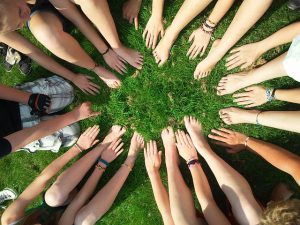Saturday
Dharma TeachingsA Quality of Healing
Basic goodness and the path of relationships
by Shastri Nick Kranz
 There are many ways to think about basic goodness. Sometimes it’s referred to as basic healthiness. When we touch into this inherent okay-ness we gain access, I believe, to a quality of healing that is much needed today. So I like to think of basic goodness as medicine — an antidote to the self doubt and self-critical mind that spoils relationships and social dynamics.
There are many ways to think about basic goodness. Sometimes it’s referred to as basic healthiness. When we touch into this inherent okay-ness we gain access, I believe, to a quality of healing that is much needed today. So I like to think of basic goodness as medicine — an antidote to the self doubt and self-critical mind that spoils relationships and social dynamics.
Without a sense of our own worthiness, we lose sight of our potential to grow together into a good human society. It’s why the mantra of the Shambhala sadhana beings with “I am basically good.” Society depends on it.
Relationships versus connections
Society today seems gripped by collective fear and doubt. In an article in Psychology Today, Robert L. Leahy Ph.D. shares the following disturbing observation: “The average high school kid today has the same level of anxiety as the average psychiatric patient in the early 1950’s.” And this observation comes from 2008 — nearly a decade ago, before the ubiquity of social media and the experience of “being alone together.”
 Shelly Turkle, a professor at MIT studying communication, encountered this haunting statement from a young person who texts religiously: “Someday, someday, but certainly not now, I’d like to learn how to have a conversation.”
Shelly Turkle, a professor at MIT studying communication, encountered this haunting statement from a young person who texts religiously: “Someday, someday, but certainly not now, I’d like to learn how to have a conversation.”
The origin of the word conversation has to do with facing one another, being present with another, conducting oneself in the world. Healthy conversations express our longing to connect. Talking and listening are important social ceremonies that create relationships and bind us as a community. If we’re not having conversations any more, how will we create society? What is being lost?
 Communication is at the core of relationships. While it might seem that communications technology would enhance relationships, the quality of our connections might actually be suffering. This notion of having quality connections — of actually being fully present for and with another person — has a very different effect on society than being loosely ‘connected’ with someone. Professor Turkle and others wonder if we’re sacrificing our relationships for instant connections.
Communication is at the core of relationships. While it might seem that communications technology would enhance relationships, the quality of our connections might actually be suffering. This notion of having quality connections — of actually being fully present for and with another person — has a very different effect on society than being loosely ‘connected’ with someone. Professor Turkle and others wonder if we’re sacrificing our relationships for instant connections.
With so many ways to connect to so many people, we now place a high value on our ability to choose where we focus our attention. A text here, a tweet there. Checking for messages while we walk, talk, eat and even drive.
Focusing awareness, cultivating compassion
In contrast, meditation shows us there is value in how we focus our attention — continuously, consciously, calmly, quietly. By bringing our minds back to a single point, our minds naturally become more focused. But also more empathetic. And more compassionate. These findings played out in research conducted at Shambhala Mountain Center a decade ago. Results from the Shamatha Project bolstered empirical studies showing the benefits of meditation and its role in developing a more empathetic response to suffering. Cultivated through mindfulness, this simple response opens up the profound possibility of relating to our own and others’ lives with compassion.
Hardwired for positive emotions
 So maybe we aren’t hardwired for selfishness after all. While certain interpretations of Darwinian theory point to selfishness as a key factor in individual survival, some would argue that this idea is at the very least incomplete and at worst tremendously misleading.
So maybe we aren’t hardwired for selfishness after all. While certain interpretations of Darwinian theory point to selfishness as a key factor in individual survival, some would argue that this idea is at the very least incomplete and at worst tremendously misleading.
In his book Born to Be Good, UC Berkeley professor Dacher Keltner contends that positive emotions such as empathy and compassion lie at the core of human nature, and we have evolved with them, not in spite of them.
Sakyong Mipham Rinpoche calls it ‘the goodness factor.’ In The Shambhala Principle, the Sakyong writes: “What has given us the upper hand in nature is our ability to organize and work together by observing, compromising, caring and responding appropriately.”
Training in emotional intelligence
The fact that we can train and develop in kindness and compassion has been known for thousands of years in the Buddhist tradition. These days, working with our minds and emotions has the flavor of a trend. Currently, it’s known as emotional intelligence. Research into how to train people in interpersonal sensitivity has produced approaches such as SEL – social and emotional learning. The Collaborative for Academic, Social and Emotional Learning (CASEL) advocates cultivating self awareness and relationship skills in the classroom. Of course, SEL isn’t an alternative to math and reading; it’s a complementary approach to learning the social and emotional skills needed to thrive in school and in the world. It might be a trend, but it’s worth paying attention to.
‘Vulnerability-bravery’
 It takes courage to be intimately present for another person, to have a conversation in the true sense of the word. It also takes courage to accommodate our impulse to withdraw and turn to our devices instead of turning to each other.
It takes courage to be intimately present for another person, to have a conversation in the true sense of the word. It also takes courage to accommodate our impulse to withdraw and turn to our devices instead of turning to each other.
When we let the world touch us, there’s a quality of bravery in holding the space for that tenderness. At the same time, there’s a vulnerability in feeling it. When experienced in a social context, this ‘vulnerability-braveness’ can help us short-circuit cultural habits of distraction and doubt and create a new culture of nowness together. Through the practice of what I call social meditation, we can empower each other to be totally comfortable to be who we really are. We can be brave and on the spot of the present moment together.
The path of relationships: the heart of community
Our existence on this planet is undeniably interdependent. We are born through another human being into a world created by many minds, many hands, many hearts. As individuals, we are inherently connected to others. We are naturally on a path of relationship. The question is: Where are we going?
Through relationships we contribute to the ceremonies and practices that build communities and create society. When we use relationships to promote our own agendas, the communities we foster lack vision and reflect selfishness. Relationships cultivated on shared principles of vulnerability and bravery lead to healthy societies based on genuine caring and connection.
When we view society through the lense of individual relationships, we realize the importance of how we conduct ourselves in these one-on-one connections, as Sakyong Mipham discusses in The Shambhala Principle.
We might even see relationships as personal expressions of activism, springboards for cultural transformation. We could do our part by seeing our ordinary relationships and connections as extraordinary opportunities to build trust in our mutual goodness. And in doing so, we could naturally radiate this inherent okay-ness to our communities and the world.
The path of relationships challenges us to awaken our intelligence and compassion. And it rewards us with the possibility of creating a sane and wakeful society. Personally, I think it’s a path worth taking.
 Shastri Nick Kranz practices social meditation and teaches on the path of relationships. For information about his online course on, click here.
Shastri Nick Kranz practices social meditation and teaches on the path of relationships. For information about his online course on, click here.





Apr 30, 2017
Reply
It’s good to see this article, Nick! I think social meditation is an incredible potent practice for these times. I feel so grateful to you for empowering and guiding so many people around the world to lead this practice.
Apr 30, 2017
Reply
Thanks for sharing Nick!